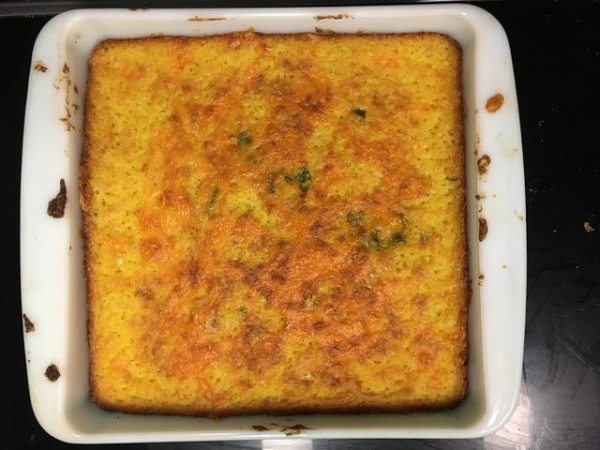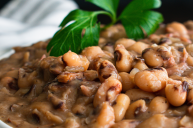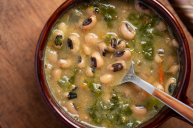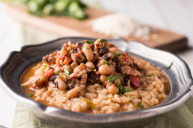All around the world, we've got different traditions to help bring in good luck in the coming year and ward off evil spirits. We get particularly excited about our various New Year's traditions.
In Spain, people all over the country gather in front of their televisions with a bowl of green grapes while wearing red underwear (long story). In Denmark, friends, and family throw dishes at your front door. The Scottish tradition of Hogmanay involves bonfires and fire festivals (burn away the evil spirits of the old year). In the American South, our culture revolves around something we all love dearly: food.
All over the United States, we celebrate New Year's Eve by watching football or going to a festive New Years' Eve party. Some stay at home with their TVs on, waiting for the ball drop in New York City at the stroke of midnight. Here in the South, we do our own thing.
Most Southern New Year's traditions generally begin and end with loved ones in the kitchen (as they should). And no matter how you slice it, tradition says you need three main components when it comes to food if you want to have a happy New Year.
1. Black-Eyed Peas
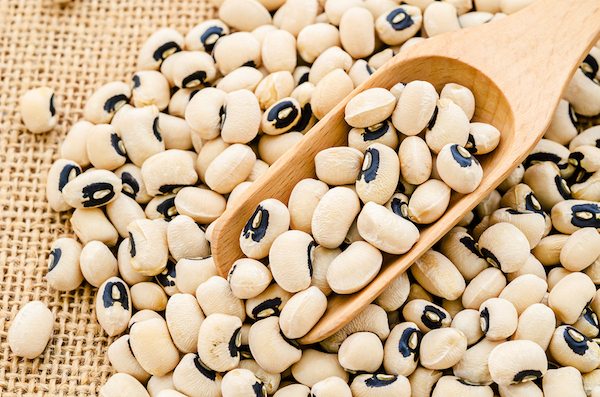
bigstockphoto.com
The tradition of eating black-eyed peas reigns in the South, but it dates back to the Jewish New Year, Rosh Hashana. However, rumor has it the Southern-based tradition started during the Civil War. Union General Sherman and his troops raided the Confederate food supplies but left the black-eyed peas and salted pork, thinking they were animal foods. The Confederate soldiers considered this good fortune since they still had food left to eat. Another tradition says African Americans ate them to celebrate their freedom when the Emancipation Proclamation went into effect on Jan. 1, 1863. Another explanation still: the peas looked like coins and signified wealth (spoiler alert: all three foods signify wealth).
How you should cook the peas is up for debate. Some New Year's Eve traditions involve cooking the black-eyed peas with a dime or coin. It's probably not the most sanitary thing, but it hammers the point home. And the person who receives the coin is then "extra lucky" the next year. Provided they don't actually swallow it, of course.
Some people fry or roast the peas. Others say the only way is to eat them as plain as possible to show "humility." And even more weird, some people go so far as to eat 365 peas, no more, no less. If you miscount the peas? Lots of bad luck...you'll have that many unlucky days in the year. Talk about a lot of pressure!
2. Collard Greens

bigstockphoto.com
Collard greens are among the healthiest Southern foods (until you cook them in a ham hock, bacon, and butter, of course). Besides being a healthy food, which brings good luck in the form of good health, collard greens are said to bring in the cash for the new year. You know, green and green and such. But there's also a pretty good reason Southerners eat greens around New Year: they're still in season! Cabbage and collard greens are both late crops in America, so it just makes sense that's the fresh green we eat for New Year's celebrations.
3. Cornbread and Ham
Rounding out the New Year's trifecta of traditional foods, an excellent steaming pan (or skillet) of cornbread represents golden opportunities and pocket money (wealth) in the New Year. Also, it's just darn tasty.
Now, no meal in the South is complete without meat. Besides loving pork all the time, Southerners celebrate New Year's by eating ham and other pork products because the animal has long been considered lucky. Along with the possible Civil War story, people consider pigs to be an animal of "progress."
For some, the specific cut of pork may turn visitors off. Hog jowls — the meaty, tough pig cheek — often make their way to New Year's Day tables in the South. Hog jowls are cured, kind of like bacon. And that's pretty much the best explanation for why they became so popular in the rural South. They kept for a long time, and one pig often fed an entire family for months.
But several other traditions don't necessarily have to do with food, either. Sure, planting a big kiss on somebody is always lovely. It's supposed to bring lots of affection in the New Year. Along with a few other traditions.
Read More: The Lucky 7 Good Luck Foods on Every Southern New Year's Table
4. Fireworks

bigstockphoto.com
Fireworks are as accepted as a New Year's Eve celebration as the Times Square ball drop or singing Auld Lang Syne. Do you know why we set off fireworks, though? If you answered, "Because blowing stuff up is fun," you're mostly right. But the tradition has much greater superstitions. Fireworks have been used in China since ancient times. That might be where the belief stems from that fireworks and firecrackers scare off all the evil spirits from year's past who may be trying to hang around too long.
In some homes, it's even customary to open the door at midnight when you make a bunch of noise to let all the "bad" out, which is a fun way to usher in a new beginning.
5. Clean Home and a Full Cupboard

bigstockphoto.com
A clean home represents a fresh start for the new year. In the South, some people even get out and put a fresh coat of paint on the house if it's warm enough. But there's a catch: make sure you get everything clean before Jan. 1 or the day after. Some traditions state nothing should leave the house on the first day of the New Year — not even old Christmas trees — to signify not losing anything important to you.
And, to make matters even more complicated, you should make sure your cupboard is full. A bare cupboard could mean a similarly barren year, and nobody wants that!
6. The First Visitor

bigstockphoto.com
This tradition has its roots in Scotland and England, but many Southerners share the same sentiment. The story goes that the first person who enters your home after midnight on New Year's Eve is a symbol of what's to come. Ideally, that person should be tall, dark-haired, and good-looking. You should reward them accordingly for entering your home and bringing good luck for the new year.

